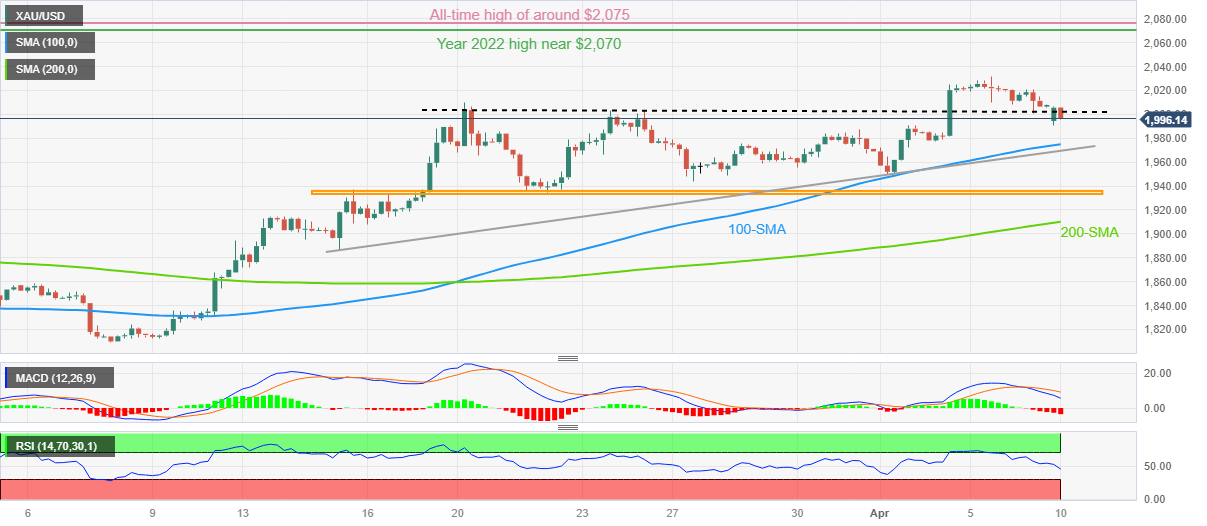- Gold price struggles to defend the first positive weekly closing in three, mildly offered of late.
- US Dollar weakness, downbeat United States statistics and recession woes underpin XAU/USD run-up.
- Holidays in multiple markets can portray softer start of the key week comprising US inflation, Federal Reserve Minutes.
Gold price (XAU/USD) extends the previous pullback from a 13-month high even as the Easter Monday holiday restricts the market moves. In doing so, the precious metal takes clues from the geopolitical challenges to the market sentiment. Also allowing the XAU/USD bulls to take a breather, after posting the first weekly gain in three, is the cautious mood ahead of this week’s top-tier data and events, namely the United States Consumer Price Index (CPI) and the latest Federal Open Market Committee (FOMC) Monetary Policy Meeting Minutes.
It’s worth noting that the fears of recession joined downbeat US data to allow the Gold price to refresh a multi-month high the previous week. However, firmer US employment numbers and the following increase in the Federal Reserve (Fed) hawkish bets prodded the bullion afterward.
Gold price rises on softer US Dollar
Gold price cheers downbeat US Dollar performance as the greenback’s gauge versus six major currencies dropped for the fourth consecutive week in the last while the XAU/USD prints the first weekly gain in three.
While tracing the US Dollar weakness, as well as the Gold price run-up, recently downbeat United States data and receding hawkish bias for the Federal Reserve (Fed) gain major attention.
That said, the US Bureau of Labor Statistics (BLS) revealed that Nonfarm Payrolls (NFP) rose by 236K in March, the lowest since January 2021 (considering the revisions), versus 240K expected and 326K prior. Further, the Unemployment Rate eased to 3.5% versus 3.6% prior while the Labor Force Participation Rate improved to 62.6% from 62.5%. Finally, annual wage inflation, per the Average Hourly Earnings, dropped to 4.2% from 4.6%, versus market forecasts of 4.3%. Previously, US JOLTS Job Openings dropped to the 19-month low in February while the ADP Employment Change for March also disappointed markets with 145K figures. Further, the US ISM Services PMI for March also amplified pessimism as it dropped to 51.2 versus 54.5 expected and 55.1 prior.
The downbeat US data also propels fears of a recession in the world’s largest economy and weigh on the US Dollar, as well as fuels the Gold price. As per the latest research, the Federal Reserve’s (Fed) preferred gauge of economic health backed the recession woes, via bond market clues. Reuters said, “Research from the Fed has argued that the ‘near-term forward spread’ comparing the forward rate on Treasury bills 18 months from now with the current yield on a three-month Treasury bill was the most reliable bond market signal of an imminent economic contraction.”
With the downbeat US data and recession woes, the Federal Reserve (Fed) officials also surrender previously hawkish bias and allow the Gold price to remain firmer. As a result, market players’ bets on the Fed’s rate hike moves have been softer of late. While portraying the same, the CME’s FedWatch Tool signals a static 71% chance of witnessing a 0.25% rate hike in May but the odds of getting a rate cut in late 2023 has recently gained attention and weighed on the US Dollar, while also fueling the XAU/USD.
Geopolitical concerns fail to tame XAU/USD bulls
While the aforementioned catalysts are mostly in favor of the Gold price, geopolitical concerns surrounding China, Russia and North Korea should have prodded the XAU/USD bulls. It should be noted that the tension between the US and China has recently escalated after Taiwan President Tsai Ing-wen’s US visit. In this regard, Reuters said that China's military simulated precision strikes against Taiwan in a second day of drills around the island on Sunday, with the island's defense ministry reporting multiple air force sorties and that it was monitoring China's missile forces. It should be noted that Russia and North Korea’s warnings to use nuclear weapons are extra catalysts that weigh on the Gold price.
While portraying the mood, the S&P 500 Futures print mild losses whereas the US 10-year and two-year Treasury bond yields keep the previous week’s downside bias around 3.37% and 3.94% respectively.
Gold buyers need validation from United States Inflation, Federal Reserve Minutes
Although the Gold bears are in command for intraday, the bulls aren’t off the table and can wait for this week’s key United States Consumer Price Index (CPI) and the latest Federal Open Market Committee (FOMC) Monetary Policy Meeting Minutes for fresh impulse. Should the Fed officials sound cautious and dump clear forward guidance on the interest rates, backed by the downbeat US inflation data, the Gold price may witness further upside.
Also read: Gold Price Weekly Forecast: Continuation of rally depends on US inflation data
Gold price technical analysis
Gold price drops back below the three-week-old previous resistance line, around $2,000 by the press time, to portray the latest fall.
Adding strength to the XAU/USD’s downside bias are the bearish signals from the Moving Average Convergence and Divergence (MACD) indicator, as well as the near-50 level of the Relative Strength Index (RSI) line, placed at 14.
That said, the 100-bar SMA and an upward-sloping support line from mid-March, around $1,975 and $1,970 in that order, restrict short-term Gold price downside ahead of the horizontal area comprising multiple levels marked since March 15, near $1,935.
Meanwhile, the Gold price trading beyond the $2,000 round figure will need to surpass the latest high surrounding $2,032 to convince XAU/USD bulls in poking the Year 2022 high of $2,070, followed by the record top surrounding $2,075.
Gold price: Four-hour chart
Trend: Further upside expected
from "price" - Google News https://ift.tt/DHWxyZU
via IFTTT

No comments:
Post a Comment